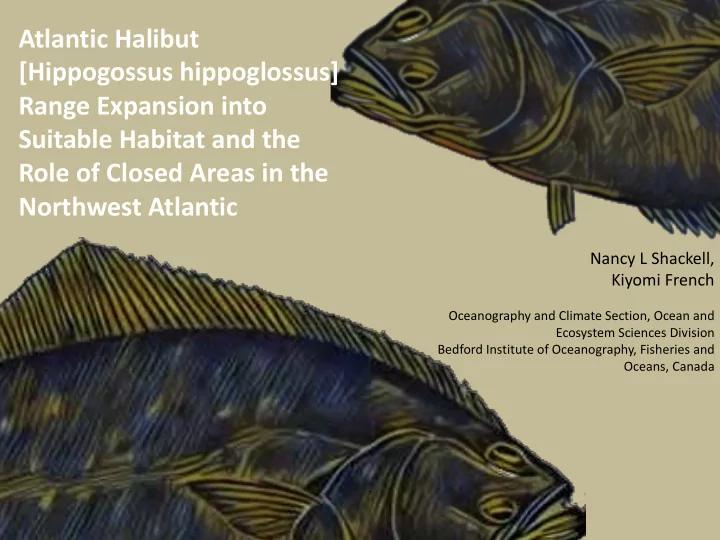

Atlantic Halibut [Hippogossus hippoglossus] Range Expansion into Suitable Habitat and the Role of Closed Areas in the Northwest Atlantic Nancy L Shackell, Kiyomi French Oceanography and Climate Section, Ocean and Ecosystem Sciences Division Bedford Institute of Oceanography, Fisheries and Oceans, Canada
Overview 1. Management and history of Atlantic halibut in Atlantic Canada 2. Habitat Suitability 3. Trends 4. Model: Effects of fishing and temperature – Effects of closed areas –
Management and history of Atlantic halibut in Atlantic Canada History of over exploitation and • Two management units • serial depletion. Both experiencing a period of high • Both as bycatch in cod fishery • juvenile recruitment and in directed halibut fishery
Gulf of Saint Newfoundland Lawrence Atlantic Ocean
Gulf of Saint Newfoundland Lawrence Atlantic Ocean
Gulf of Saint Newfoundland Lawrence Atlantic Ocean
Gulf of Saint Newfoundland Lawrence EEZ Atlantic Ocean 1977- Exclusive Economic Zone (EEZ), closed to foreign fisheries = dramatic reduction in landings and increase in abundance of all groundfish species
Gulf of Saint Newfoundland Lawrence Atlantic Ocean
Gulf of Saint Newfoundland Lawrence Atlantic Ocean
Gulf of Saint Newfoundland Lawrence Atlantic Ocean
Gulf of Saint Newfoundland Lawrence Atlantic Ocean
Gulf of Saint Newfoundland Lawrence Atlantic Ocean Establish Total Allowable Catch (TAC) and minimum fish length (81cm) in halibut fishery
Gulf of Saint Newfoundland Lawrence Atlantic Ocean
Gulf of Saint Newfoundland Lawrence Atlantic Ocean
Gulf of Saint Newfoundland Lawrence Atlantic Ocean
Gulf of Saint Newfoundland Lawrence Atlantic Ocean
Gulf of Saint Newfoundland Lawrence Atlantic Ocean
Gulf of Saint Newfoundland Lawrence Atlantic Ocean
Gulf of Saint Newfoundland Lawrence Atlantic Ocean
Gulf of Saint Newfoundland Lawrence Atlantic Ocean
Gulf of Saint Newfoundland Lawrence Atlantic Ocean
Gulf of Saint Newfoundland Lawrence Atlantic Ocean
Gulf of Saint Newfoundland Lawrence Atlantic Ocean
Gulf of Saint Newfoundland Lawrence Atlantic Ocean
Gulf of Saint Newfoundland Lawrence Atlantic Ocean
Gulf of Saint Newfoundland Lawrence Atlantic Ocean
Abundance Trends South North Dotted line represents cod moratorium (1992-1994) • Noticeable dip in biomass around time of cod moratorium • Currently experiencing a period of high recruitment • Spatial aspect: Rate of increase varies across stock area •
What variables are influencing / shaping this resurgence? Habitat suitability? Fishing? Temperature?
Habitat Suitability Found relation between relative availability of suitable habitat and relative landings (recent and historic) Consistent with • nursery size hypotheses Suggests spatial • structure is more complex than previously assumed Also suggests lower • levels of migration Considerable • amounts of unoccupied- yet suitable habitat (French et al. in press)
Habitat Suitability Found relation between relative availability of suitable habitat and relative landings (recent and historic) Consistent with • Habitat Suitability Value nursery size hypotheses 0 - 0.25 à Poor Suggests spatial • 0.26 – 0.50 à Marginal structure is more complex than 0.51 – 0.75 à Good previously assumed 0.76 - 1 à Optimal Also suggests lower • levels of migration Considerable • amounts of unoccupied- yet suitable habitat (French et al. in press)
Habitat Suitability (2/2) South North
Temperature Trends Most optimal habitat corresponds with warmer waters • Designer plotting by Torkild Tverraa
Occupancy Trends Higher occupancy in • more suitable regions Probability of • increase over time is less in peripheral regions
Fishing Before and After Moratorium Change (Million kg) Landings of cod, halibut and • NAFO Before After Difference other groundfish have 2J 1960.1 44.9 -1915 (98%) decreased dramatically since the 3K 2492.1 86.6 -2405 (97%) cod moratorium (1992-1994) 4Vn 637 19.6 -617 (97%) 4Vs 967.8 29.6 -938 (97%) https://www.nafo.int/Data/STATLANT
Fishing Trends • Always relatively high in 3P Also high in 4X and • 5YZe (no cod moratorium ) https://www.nafo.int/Data/STATLANT
Model: Holding all else constant, is the presence of halibut influenced by temperature and/or fishing? Best Model: • Generalized linear mixed effects model • Presence : binomial response • Random effects: Year, NAFO, habitat suitability • Interactions: Fishing (cod & halibut landings), temperature
Model Estimates Higher in the gulf of saint Lawrence and • on the Scotian Shelf Lower in more peripheral and/or • northern regions
Model Estimates in odds ratios Halibut presence is influenced by temperature and fishing
Do fishery closures play a role? Persistent core areas in • times of low abundance located on Browns bank and on top of the Gully and their relation to fishery closures …Core areas in 3OP never returned post- moratorium (Boudreau et al, 2017)
Closed Areas Year Closure Name NAFO Closed Type Browns Feb 1- 4X 1972 Bank June 15 Haddock Year- 4W 1993 Box round Jan 1- 4VsB 4VS 1995 April 30
Model: What is the effect of closed areas and temperature holding all else constant? Best Model: • Generalized linear mixed effects model • Presence : binomial response • Random effects: Year, NAFO, habitat suitability • Interactions: Fishery Closure (binomial), temperature
Model Estimates in odds ratios Halibut presence is influenced by temperature and closed areas
Range expansion and secondary role of closed areas Higher presence in more suitable habitat, abundances increasing annually in all types, suggesting continued growth Fishing, temperature and Fishery closures influence the probability of halibut being present in a given year, habitat suitability type and NAFO region. Higher presence values on the scotia shelf and in the Gulf of Saint Lawrence. Lower in Newfoundland and the United States, where landings are relatively high, and less closures .
(Nancy Shackell, Nell den Heyer, Kiyomi French/DFO, Canada) Q: Are the following consistent with current stock unit domain? Size of Juvenile Connectivity Mature female Habitat ~ Adult Life history trait Current=2000km; Residents: 6 km Estimated=250km Winter Migration: <250km landings Working Hypothesis: multiple sub stocks? • Is one sub stock rescuing another? Does management strategy appropriately allocate TAC’s and are we • handicapping recovery in some areas? Genetic landscape (in progress) Shackell et al. 2016 ICESJMar, Boudreau et al. 2017 Ecol&Evol 44 French et al. in press. Fish Bull.
Thank you • IFS • IGS
Model Estimates NAFO Habitat Suitability Optimal 4Vs 4X Marginal 4w NAFO intercepts are comparable Optimal habitat = higher presence
Recommend
More recommend